My friend Barbara Lea has been working on a moving and disturbing project. She's painting portraits of all the female American soldiers killed in Iraq. Unfortunately, it's a work in progress. Visit the website.
I hate this war.
Moving and disturbing indeed, hits hard
I really don't get this work. Am I supposed to be surprised that people die in war? Or that those people have names and faces? or that some of those people are women? Frankly, I think that the fact that there are only 69 of them so far give fule to arguments on the right. The right is not confused about this - you go to war and people die. "Only 69 women so far? That's pretty good!"
It's inevitable that most of these women died believing that they died for a just cause. We may find this ridiculous but many (most) of them did not. If my loved one died and the religious right used their image and name to promote their agenda I'd be pissed. I would demand that if they can't treat my beliefs with respect that they have the courtesy to leave me alone. In this sense the piece has a bitter edge that is never addressed in the work itself. It is not a memorial (as much as it pretends to be).
I think you are being overly harsh, Joester. This isn't news, and it isn't propaganda. I don't see any danger of fuelling the right wing, as all the information is already freely available. What I get from this work is a strong sense of personal dismay. Also self-respect on the part of the artist in refusing to turn away from the ongoing facts that she deplores. The part where I sort of agree with you, is a part I sort of like. I think there is an invasive aspect to this. The artist is using images of real dead soldiers as a way to deal with her own civilian relationship to the war. But I don't mind that bitterness, as you put it. And I disagree that there is pretense, I think this aspect of detachment from the individuals themselves is expressed in the project.
I like Lea's use of the phrase "traditionally tender." I think it speaks to her position as a portrait painter, as well as to the gender role.
By contrast, there is this piece about casualties in Iraq by Steve Reinke, which is disturbing in a different set of ways.
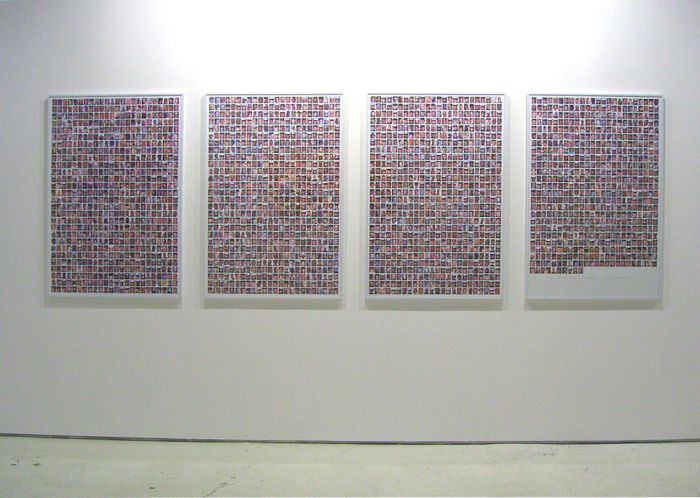
from Xtra:
"Picture it: More than 2,000 wallet-sized colour photos of members of the United States military, overwhelmingly male, downloaded and arranged carefully in rows. You cast an eye on every image, taking them all in, until your gaze reaches the end of the collection and its raw caption: "The American military casualties of the Second Gulf War for whom photographs were available as of Oct 7, 2006 arranged by attractiveness." A punch line... but for a joke that's not funny. Welcome to Steve Reinke's latest and most ruthless anti-monument to US culture."
I thought of the Reinke piece last night when I read joester's comment. For the record, I thought that Reinke did something cruel and brilliant.
I agree with Sally when she wrote:"The artist is using images of real dead soldiers as a way to deal with her own civilian relationship to the war" But for me, it fails to really poke very deeply into that uncomfortable relationship that we have with the biggest spectacle, but Reinke succeeds.
I have also always liked Christian Boltanski's Dead Swiss for being so blandly departed:
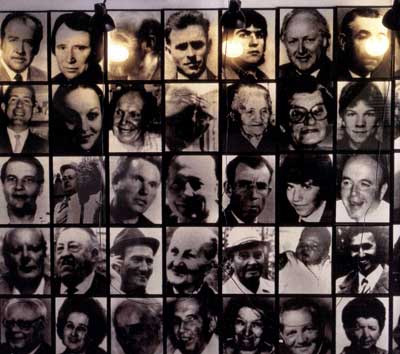
In some ways Barbara Lea and Steve Reinke are not so different. Each is positioning themselves, and explicitly connecting with this data of the dead according to their own frame of reference. Reinke's take is that of a gay male, Lea's is that of a woman. When I was a kid, the idea of American women dying in combat was pretty unusual. Lea's project points out a recent major cultural shift with regard to gender roles. It's this aspect of sisterhood that is the most poignant element in her project, sad because it almost feels outdated, as if it is an inappropriate lens to apply to war. If we are happy about job-equity and female hockey teams, then how can we complain about women in the armed forces? Lea states,
What happens when the mothers of warriors become the warriors themselves? When the traditionally tender become inseparably involved in brutal warfare?
Could the inclusion of women among those sacrificed eventually tame the fury of war?
But the converse could also be true, that the inclusion of women in combat indicates that brutality is on the rise. I don't know where I situate myself in this (for instance, I'm of the mind that women are as cabable of brutality as men, given the opportunity), but I do appreciate the pause for reflection that the piece provides. The work feels much more like a query than a statement to me, and a sideways step out of the deadening relentlessness of this stupid war.
reinke's work looks clinically arousing, cooly detached to the point of pain. Orwellian hell spelled out like a stock-ticker across four tombstones. to me it looks far more outdated then Barb Lea's presentation. yes, mindless fascism is very much present in the world. but why must conventional high taste respond to it by building symbollically spotless tombs?
Barb Lea deals with malleable, mutable flesh. Her portraits are like fingerpaintings obliquely pressured against by one's own face in a mirror. This is the sort of art that comes crumpled out of pockets and gets passed around between people and tacked up on walls without knowing who's portraits they are.
I'd only argue with your last sentence, work with the painterly qualities that Barbara's stuff has certainly doesn't get crumpled up in someone's pockets.
The contrasts between the two are interesting to me. Art fag #16 reviewed his work and this quote on "the Reinke universe" is to the point:
"Depending on your inclinations, it might be a nice place to visit; it is certainly not a nice place to live. Mr. Reinke exercises a particular brand of cruelty in his new work, which has become distinctly more pungent since, say, the Hundred Videos."
Interesting to note home many are reported to have been killed by "makeshift bombs". I'm not sure how I feel about this work- I like the painting, but in the end, they seem anonymous to me. I want to know who they were, as women, and as warriors. Maybe they were all like Linndy England? Or were they brave, throwing themselves on top of an IED, after the last of the silly string ran out?
We can always use more silly string:
http://www.msnbc.msn.com/id/16079446/
That's the argument against the paintings resembling those homemade tributes that b-man alluded to earlier. The people who create that sort of tribute to someone they have lost are particular in their need for a likeness, the loss is of someone distinct and irreplaceable, some one they loved.
Thinking about this led me to think about WAVs WACs and WASPs in WWII, and a bit of googling and wiki-ing led here:
http://www.archives.gov/publications/prologue/1993/spring/women-in-the-civil-war-1.html
I had no idea.
For the record B-man, I wasn't saying that I think Barb's work is outdated. I'm seeing the vague outdatedness feeling of the sisterhood aspect as a kind of intentional wakeup call on her part.
Great link, Rob. Some of the pictures are so good I just had to poach 'em.
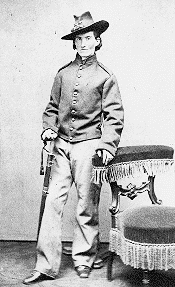 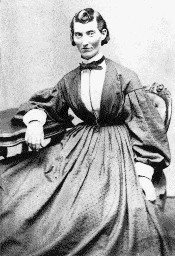
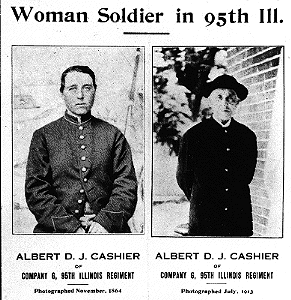
As a result of this project, I have come to see war as a masculine pursuit. Something that is deeply sexualized.
President Lydon Johnson said of the damage inflicted on Vietnamese communists during the 1968 Tet offensive, "I didn't just screw Ho Chi Minh. I cut his pecker off!"
What do you think the response to this project would be if I hadn't painted the faces of these women but only their mouths? or their breasts?
I knew an ex-soldier who told me that all his army training was delivered with a major dose of misogyny.
My honest answer to your final question would be that then the work could have ended up as a didactic that went nowhere as an art piece.
I also have to question your assertion that deeply sexualized automatically equates to masculinity.
Also Johnson was unusually vulgar even for a Texan.
In war, there is a feminization of the emeny. This may, and does confuse the troops who have women in their ranks.
If male soldiers use gender to represent domination, where does that put women who fight with them?
dont ask (or tell). sometimes, it goes both ways.
"If male soldiers use gender to represent domination, where does that put women who fight with them?" I was thinking about this when I read in Rob's link about the army's denial of the participation of female soldiers in the US civil war.
Barb, thanks for posting! To respond to your question, I think that would have made your project more similar to Reinke's. Is that what you are getting at?
Judging from the comments on your website, it seems like the response has been primarily positive. Do you feel that people are getting what you want them to get from the project?
Didnít mean to hit and run, I was away from my computer for a while.
I am being overly harsh, especially with Barbaraís work in particular.
There have been some interesting confrontations in San Francisco. A protester has a hill with crosses and names of every dead soldier. One of the fathers of a Soldiers made a big stink about using his sonís name in an anti-war piece. While the whole thing became a media frenzy and blown out of proportion, it did raise some issues for me. The protester actually removed all the names from his piece.
There are a lot of projects right now that are documenting the American deaths from the images in the paper. Where are the projects that honor the death of the people these Americans are killing? We donít have access to these people, but they are the victims I most care about in this war. These projects make me feel like weíre honoring the prison guards and ignoring the prisoners.
Steve Mumford is a painter doing some interesting work on the war. He is embedded with the army.
http://www.postmastersart.com/
Iíve been reading Honor the Fallen on the Military Times. http://www.militarycity.com/valor/honor.html The writing is blunt and sad and honest. And surprisingly critical of the military.
I came to the project wanting to change the focus of my work, to open it outward, to use my visual abilities to further the kind of thinking that includes understanding the other's point of view. This was my starting point. I do not think I have been successful in this particular intention for other viewers. I have, however, for myself. And what irony there is in that.
I began the work feeling these deaths were part of a larger and unexcuseable tradegy. and I ended up with the strong sense that if there is going to be fighting, these women have every right to be there. They have every right to be there and to be killed. The right to death.
So, I see this as the foundation of a certain weakness or perhaps inconsistency in the piece, which has been picked up here by Joe especially, since I do not address it anywhere.
but that aside, I continue to be surprised at the strength and range of responses. One blogger interpreted it as chauvanistic.
The Mumford work (thanks for the link, joester) also brings up the big problem of dealing with war with full integrity an artist needs for their work. I think it's the hardest stuff to make because the artist becomes implicated in someway once they start. The shabby tools we all have at hand, to deal with all that's astounding about it, ends up making you feel vulnerable. Reinke will have nothing to do with the vulnerability, and to me Lea takes it on. (But I don't think they are in opposition)
I'm also thinking of John Scott, can't find many of his war images on line so here's
"Trans-Am Apocalypse No. 2" from 1993
(a trans-am with the Book of Revelations scratched by hand onto the body)
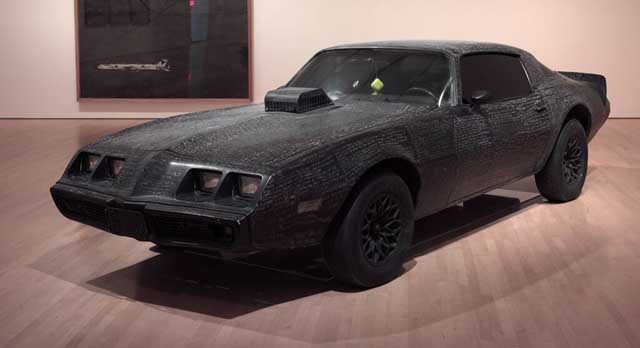
|
My friend Barbara Lea has been working on a moving and disturbing project. She's painting portraits of all the female American soldiers killed in Iraq. Unfortunately, it's a work in progress. Visit the website.
- sally mckay 3-29-2007 10:22 pm
I hate this war.
- mark 3-30-2007 1:27 am
Moving and disturbing indeed, hits hard
- galenagalaxian 3-30-2007 4:50 am
I really don't get this work. Am I supposed to be surprised that people die in war? Or that those people have names and faces? or that some of those people are women? Frankly, I think that the fact that there are only 69 of them so far give fule to arguments on the right. The right is not confused about this - you go to war and people die. "Only 69 women so far? That's pretty good!"
It's inevitable that most of these women died believing that they died for a just cause. We may find this ridiculous but many (most) of them did not. If my loved one died and the religious right used their image and name to promote their agenda I'd be pissed. I would demand that if they can't treat my beliefs with respect that they have the courtesy to leave me alone. In this sense the piece has a bitter edge that is never addressed in the work itself. It is not a memorial (as much as it pretends to be).
- joester 3-30-2007 6:16 am
I think you are being overly harsh, Joester. This isn't news, and it isn't propaganda. I don't see any danger of fuelling the right wing, as all the information is already freely available. What I get from this work is a strong sense of personal dismay. Also self-respect on the part of the artist in refusing to turn away from the ongoing facts that she deplores. The part where I sort of agree with you, is a part I sort of like. I think there is an invasive aspect to this. The artist is using images of real dead soldiers as a way to deal with her own civilian relationship to the war. But I don't mind that bitterness, as you put it. And I disagree that there is pretense, I think this aspect of detachment from the individuals themselves is expressed in the project. I like Lea's use of the phrase "traditionally tender." I think it speaks to her position as a portrait painter, as well as to the gender role.
By contrast, there is this piece about casualties in Iraq by Steve Reinke, which is disturbing in a different set of ways.
- sally mckay 3-30-2007 7:06 pm
from Xtra:
- L.M. 3-30-2007 7:40 pm
I thought of the Reinke piece last night when I read joester's comment. For the record, I thought that Reinke did something cruel and brilliant.

I agree with Sally when she wrote:"The artist is using images of real dead soldiers as a way to deal with her own civilian relationship to the war" But for me, it fails to really poke very deeply into that uncomfortable relationship that we have with the biggest spectacle, but Reinke succeeds.
I have also always liked Christian Boltanski's Dead Swiss for being so blandly departed:
- L.M. 3-30-2007 7:52 pm
In some ways Barbara Lea and Steve Reinke are not so different. Each is positioning themselves, and explicitly connecting with this data of the dead according to their own frame of reference. Reinke's take is that of a gay male, Lea's is that of a woman. When I was a kid, the idea of American women dying in combat was pretty unusual. Lea's project points out a recent major cultural shift with regard to gender roles. It's this aspect of sisterhood that is the most poignant element in her project, sad because it almost feels outdated, as if it is an inappropriate lens to apply to war. If we are happy about job-equity and female hockey teams, then how can we complain about women in the armed forces? Lea states,
But the converse could also be true, that the inclusion of women in combat indicates that brutality is on the rise. I don't know where I situate myself in this (for instance, I'm of the mind that women are as cabable of brutality as men, given the opportunity), but I do appreciate the pause for reflection that the piece provides. The work feels much more like a query than a statement to me, and a sideways step out of the deadening relentlessness of this stupid war.- sally mckay 3-30-2007 8:07 pm
reinke's work looks clinically arousing, cooly detached to the point of pain. Orwellian hell spelled out like a stock-ticker across four tombstones. to me it looks far more outdated then Barb Lea's presentation. yes, mindless fascism is very much present in the world. but why must conventional high taste respond to it by building symbollically spotless tombs?
Barb Lea deals with malleable, mutable flesh. Her portraits are like fingerpaintings obliquely pressured against by one's own face in a mirror. This is the sort of art that comes crumpled out of pockets and gets passed around between people and tacked up on walls without knowing who's portraits they are.
- b-man (guest) 3-30-2007 10:54 pm
I'd only argue with your last sentence, work with the painterly qualities that Barbara's stuff has certainly doesn't get crumpled up in someone's pockets.
The contrasts between the two are interesting to me. Art fag #16 reviewed his work and this quote on "the Reinke universe" is to the point:
- L.M. 3-30-2007 11:22 pm
Interesting to note home many are reported to have been killed by "makeshift bombs". I'm not sure how I feel about this work- I like the painting, but in the end, they seem anonymous to me. I want to know who they were, as women, and as warriors. Maybe they were all like Linndy England? Or were they brave, throwing themselves on top of an IED, after the last of the silly string ran out?
We can always use more silly string:
http://www.msnbc.msn.com/id/16079446/
- Rob (guest) 3-31-2007 12:55 am
That's the argument against the paintings resembling those homemade tributes that b-man alluded to earlier. The people who create that sort of tribute to someone they have lost are particular in their need for a likeness, the loss is of someone distinct and irreplaceable, some one they loved.
- L.M. 3-31-2007 1:05 am
Thinking about this led me to think about WAVs WACs and WASPs in WWII, and a bit of googling and wiki-ing led here:
http://www.archives.gov/publications/prologue/1993/spring/women-in-the-civil-war-1.html
I had no idea.
- rob (guest) 3-31-2007 1:42 am
For the record B-man, I wasn't saying that I think Barb's work is outdated. I'm seeing the vague outdatedness feeling of the sisterhood aspect as a kind of intentional wakeup call on her part.
- sally mckay 3-31-2007 1:49 am
Great link, Rob. Some of the pictures are so good I just had to poach 'em.



- sally mckay 3-31-2007 2:05 am
As a result of this project, I have come to see war as a masculine pursuit. Something that is deeply sexualized.
President Lydon Johnson said of the damage inflicted on Vietnamese communists during the 1968 Tet offensive, "I didn't just screw Ho Chi Minh. I cut his pecker off!"
What do you think the response to this project would be if I hadn't painted the faces of these women but only their mouths? or their breasts?
- Barbara Lea (guest) 3-31-2007 5:37 am
I knew an ex-soldier who told me that all his army training was delivered with a major dose of misogyny.
- L.M. 3-31-2007 6:34 am
My honest answer to your final question would be that then the work could have ended up as a didactic that went nowhere as an art piece.
- L.M. 3-31-2007 6:42 am
I also have to question your assertion that deeply sexualized automatically equates to masculinity.
- L.M. 3-31-2007 6:45 am
Also Johnson was unusually vulgar even for a Texan.
- tom moody 3-31-2007 6:52 am
In war, there is a feminization of the emeny. This may, and does confuse the troops who have women in their ranks.
If male soldiers use gender to represent domination, where does that put women who fight with them?
- anonymous (guest) 3-31-2007 8:29 am
dont ask (or tell). sometimes, it goes both ways.
- bill 3-31-2007 12:21 pm
"If male soldiers use gender to represent domination, where does that put women who fight with them?" I was thinking about this when I read in Rob's link about the army's denial of the participation of female soldiers in the US civil war.
Barb, thanks for posting! To respond to your question, I think that would have made your project more similar to Reinke's. Is that what you are getting at?
Judging from the comments on your website, it seems like the response has been primarily positive. Do you feel that people are getting what you want them to get from the project?
- sally mckay 3-31-2007 7:14 pm
Didnít mean to hit and run, I was away from my computer for a while.
I am being overly harsh, especially with Barbaraís work in particular.
There have been some interesting confrontations in San Francisco. A protester has a hill with crosses and names of every dead soldier. One of the fathers of a Soldiers made a big stink about using his sonís name in an anti-war piece. While the whole thing became a media frenzy and blown out of proportion, it did raise some issues for me. The protester actually removed all the names from his piece.
There are a lot of projects right now that are documenting the American deaths from the images in the paper. Where are the projects that honor the death of the people these Americans are killing? We donít have access to these people, but they are the victims I most care about in this war. These projects make me feel like weíre honoring the prison guards and ignoring the prisoners.
Steve Mumford is a painter doing some interesting work on the war. He is embedded with the army.
http://www.postmastersart.com/
Iíve been reading Honor the Fallen on the Military Times. http://www.militarycity.com/valor/honor.html The writing is blunt and sad and honest. And surprisingly critical of the military.
- joester 3-31-2007 8:57 pm
I came to the project wanting to change the focus of my work, to open it outward, to use my visual abilities to further the kind of thinking that includes understanding the other's point of view. This was my starting point. I do not think I have been successful in this particular intention for other viewers. I have, however, for myself. And what irony there is in that.
I began the work feeling these deaths were part of a larger and unexcuseable tradegy. and I ended up with the strong sense that if there is going to be fighting, these women have every right to be there. They have every right to be there and to be killed. The right to death.
So, I see this as the foundation of a certain weakness or perhaps inconsistency in the piece, which has been picked up here by Joe especially, since I do not address it anywhere.
but that aside, I continue to be surprised at the strength and range of responses. One blogger interpreted it as chauvanistic.
- b lady (guest) 3-31-2007 10:09 pm
The Mumford work (thanks for the link, joester) also brings up the big problem of dealing with war with full integrity an artist needs for their work. I think it's the hardest stuff to make because the artist becomes implicated in someway once they start. The shabby tools we all have at hand, to deal with all that's astounding about it, ends up making you feel vulnerable. Reinke will have nothing to do with the vulnerability, and to me Lea takes it on. (But I don't think they are in opposition)

I'm also thinking of John Scott, can't find many of his war images on line so here's
"Trans-Am Apocalypse No. 2" from 1993
(a trans-am with the Book of Revelations scratched by hand onto the body)
- L.M. 3-31-2007 11:08 pm